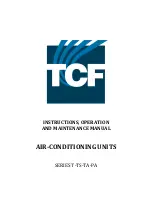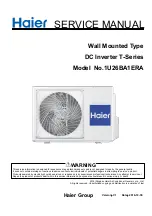
7
NOTE
NOTE
NOTE
• Never press the button of the remote control-
ler with a hard, pointed object.
The remote controller may be damaged.
• Never pull or twist the electric wire of the
remote controller.
It may cause the unit to malfunction.
• Do not place appliances which produce open
fire in places exposed to the air flow from the
unit or under the indoor unit. It may cause
incomplete combustion or deformation of the
unit due to the heat.
• Arrange the drain hose to ensure smooth
drainage. Incomplete drainage may cause
wetting of the building, furniture etc.
• Do not place the controller exposed to direct
sunlight.
The LCD display may get discolored, failing to
display the data.
• Do not wipe the controller operation panel
with benzine, thinner, chemical dustcloth, etc.
The panel may get discolored or the coating
peeled off. If it is heavily dirty, soak a cloth in
water-diluted neutral detergent, squeeze it well
and wipe the panel clean. And wipe it with another
dry cloth.
• Dismantling of the unit, treatment of the refrig-
erant, oil and eventual other parts, should be
done in accordance with the relevant local
and national regulations.
• Do not dry the filter by exposing it to direct
sunlight or warming it using fire, etc. Doing so
can result in the deformation of the filter.
If the temperature or the humidity is beyond the fol-
lowing conditions, safety devices may work and the
air conditioner may not operate, or sometimes,
water may drop from the indoor unit.
D
B: Dry bulb temperature (
°
F)
WB: Wet bulb temperature (
°
F)
The setting temperature range of the remote con-
troller is 60°F to 90°F.
Regarding places for installation
• Is the air conditioner installed at a well-venti-
lated place where there are no obstacles
around?
• Do not use the air conditioner in the following
places.
a. Filled with much mineral oil such as cutting oil
b. Where there is much salt such as a beach area
c. Where sulfured gas exists such as a hot-spring
resort
d. Where there are considerable voltage fluctua-
tions such as a factory or plant
e. Vehicles and vessels
f. Where there is much spray of oil and vapor
such as a cookery, etc.
g. Where there are machines generating electro-
magnetic waves
h. Filled with acid and/or alkaline steam or vapor
• Is a snow protection measure taken?
For details, consult your dealer.
Regarding wiring
• All wiring must be performed by an authorized
electrician.
To do wiring, ask your dealer. Never do it by your-
self.
• Make sure that a separate power supply cir-
cuit is provided for this air conditioner and
that all electrical work is carried out by quali-
fied personnel according to local laws and
regulations.
Pay attention to running noises, too
• Are the following places selected?
a. A place that can sufficiently withstand the
weight of the air conditioner with less running
noises and vibrations.
b. A place where the hot wind discharged from
the air outlet of the outdoor unit and the running
noises.
• Are you sure that there are no obstacles near
the air outlet of the outdoor unit?
Such obstacles may result in declined perfor-
mance and increased running noises.
• If abnormal noises occur in use, consult your
dealer.
Regarding drainage of drain pipe
• Is the drain pipe executed to perform com-
plete drainage?
If proper drainage is not carried out from the out-
door drain pipes during air-conditioning operation,
chances are that dust and dirt are clogged in the
pipe. This may result in a water leakage from the
indoor unit. Under such circumstances, stop the
operation of the air conditioner, and then consult
your dealer or our service station.
3. OPERATION RANGE
OUTDOOR
UNIT
OPERATION
TEMPERATURE (
°
F)
OUTDOOR
INDOOR
RZQ24·30·
36·42MVJU
COOLING
23 to 115 (DB) 57 to 77 (WB)
HEATING
5 to 64.5 (WB) 59 to 80.5 (DB)
4. INSTALLATION SITE
01_EN_3PN05140-8W.fm Page 7 Wednesday, September 14, 2005 2:06 PM


































